- Getting around Lijiang. Dont stay in the Old Towns more than 2 days, there is nothing to do. KRISS Oct 9, 2013 05:46
- 2013 Beijing Temple Fair BENNYLAU Feb 26, 2013 03:29
- Malaysian traveling from KUL - LAX vis Shanghai PVG ZATI_DY Jan 3, 2013 20:15
<a>Beijing: A Weekend Whirlwind
- Views: 4100
- |Vote: 2 0
- |Add to Favorites
- |Recommend to Friends
Getting There
As Beijing prepares for the Olympic games, it’s hard to find any part of the city that isn’t undergoing some kind of renovation. The crowded capital is not only expanding its horizontal sprawl, but it’s also revamping its transportation systems and using paint to inject some life back into its most famous historical sites. Construction cranes and unfinished buildings dominate the skyline during the long taxi ride from the airport into downtown, where huge office buildings, hotels and markets brace for the economic frenzy set to hit in 2008. Brand new yellow and green Volkswagen taxis (the kind that charge two yuan per mile) have supplanted the boxy, red Volkswagen santanas normally seen in Chinese cities. While the hutongs (alleyways that embody the heart of the ancient city) remain intact, rapid modernization promises to make modern Beijing more accessible to foreign tourists.
The march of progress didn't stop for me as I swooped into Beijing last summer. I had two days before my connecting flight to Yunnan, and despite jetlag, I decided to embark on a whirlwind tour of the city’s most famous tourist sites.
I checked into the Sino-Swiss, a relatively pricey but highly convenient hotel near the airport. For the most part, it was a standard Chinese hotel—low water-pressure in the bathroom, firm beds, less-than-perfect upholstery on the furniture. But a few things made the Sino-Swiss stand out in the crowd. For starters, this place had an enormous pool, a free breakfast bar that offered a delicious sampling of both eastern and western cuisine, and a friendly, courteous staff with a decent amount of English speakers.
As I mentioned before, the taxi-ride into downtown is long and expensive for Chinese standards. Last summer, it was a little over 100 yuan (about $12.50 USD) one way. But at least I got my money’s worth. My cab had a VCD/DVD player built into the visor. Mr. Ma, my driver, apparently enjoyed the karaoke videos and the blaring music. Or maybe he was just laughing at how I sang along with about 20 percent of the Chinese characters that scrolled across the screen.
Entering the Forbidden City
A half-hour later, we arrived at the northern gate of Beijing's Forbidden City. Coming here would be one of the highlights of my trip. For me, seeing sites isn't about a traveler's bragging rights. They're portraits of history, tools to help understand a culture with a mindset and heritage vastly different than my own. And for a country as ancient as China, history is the prized possession.
The sheer size of the northern gate took me aback. With the pagoda-style roof, cylindrical columns and traditional red, gold, blue and green paint, it boasted the traditional architecture imitated in Chinese restaurants in America. While this gave it an air of familiarity, I realized I was now looking at the archetype, the model from which all the impostors got their roots.
A thick red wall stood about 20 feet high and surrounded the entire complex, which is said to cover about 2 square miles. I wondered if it has always been red, or if it was painted that color after the Communist takeover in 1949. People swarmed the paved area outside the gate. An Indian family snapped a picture. A Chinese couple stared at the city in awe; their traveling dream was close to fulfillment. And our group of 13 Americans moved toward the ticket booth, where those waiting had surprisingly formed the semblance of a queue. Desperate tour guides barked at foreigners in multiple languages hoping for a group to enlist their services. Looking at the teeming masses of people, I thought "Forbidden City" is hardly an appropriate name for a place so crowded.
In fact, if you have 60 yuan to spend, the heavy, gold-studded doors fling open and usher you into the playground of the 13th-century ruling class. The walled complex, built during the Ming dynasty, is known as "forbidden" because of its original purpose—to keep Heaven-ordained emperors and other members of the elite class from mingling with the common people. While the city was still in use, it served its purpose well, but this isolation left the emperors largely uninformed about the lives of the people they ruled. So emperors delegated away a lot of the authority and served more as ceremonial figureheads than active leaders.
With more time, I would definitely recommend getting a guide. If you’re too cheap for that, make sure you do tons of research on the internet before you get there so you’ll know what you’re looking at. English signs are few and far between, and they’re usually shoddy translations that are more humorous than informative.
The Gate of Heavenly Peace
Few westerners know that Tiananmen literally translates to "Gate of Heavenly Peace," and as we made the rounds, I found out just how ironic that name is.
We exited the rectangular complex of the Forbidden City on the south side through Tiananmen, which opens into the square of the same name, a huge concrete mall lined with government buildings on all sides and dotted with monuments heralding the exploits of influential party members. The square is modeled after Moscow’s Red Square, and it’s interesting to see the Soviet architecture juxtaposed with the traditional Chinese buildings in the Forbidden City. Each style helps tell the story of 20th-century China, the gradual shift from the secluded rule of the emperors in the Forbidden City to the Communist rule established by Mao Ze Dong in 1949.
As I was researching Beijing, I thought my ideal itinerary in the Forbidden City would start by passing under Qianmen, the "front gate" south of the square, then traversing the square and entering through Tiananmen, beneath Mao’s giant portrait, which hangs above the center of three alcoves.
Heaven's Blessing
Tiantan, the Temple of Heaven, is only 10 or 15 minutes away from Tiananmen Square by bus, depending on the traffic. As I found out, the McDonald’s south of the square is a convenient pit-stop before heading east to the Temple.
The Temple, built in the 15th century by the Ming Dynasty, was a place reserved for the emperor and his attendants, where he would go to make sacrifices to appease the gods (or the fate-driven cycle) that produced a plentiful harvest throughout the land. I could spend days researching the many ways the imperial number nine is incorporated into the architecture or describing the way the cosmology of the day is reflected in the roundness of the three tiers of the temple's main structure.
But the most interesting thing about this place is looking beyond the present-day structures to their ancient precursors. What made the Ming emperor and his court choose this particular site upon which to build their premiere temple? It's likely that it was a sacrificial site before construction ever began. And the fact that sacrifices occurred before 1420 AD begs the question: From where did the Chinese inherit a sacrificial system?
Heaven holds a prominent place in the traditional Chinese belief system. Of course, when the Chinese say "heaven," they don't mean it in the Judeo-Christian sense. While I’m no expert on their view, I do know that it's steeped in Confucian and Daoist traditions. Defining Chinese cosmology is a tricky thing because it changes depending on what mix of belief systems is operating. I think it's safe to say that in heaven can be both a realm that houses deities and a fate-like entity that guides events on earth.
Unfortunately, due to renovations, I had to speculate about what the inside of the complex looked like. The Hall of Prayer for Good Harvests, the three-tiered, circular, orb-topped building featured on postcards of Tiantan, was only visible at the points where it peeked over the outside the walls of the complex. Apparently, the government cares more about the millions of people who’ll see Tiantan during the Olympics than a few foreigners that tried to sneak in right before closing time. I can’t say I don’t understand.
Having given it my best shot, I exited on the north side of Tiantan park, a beautiful and peaceful retreat stuck in the middle of bustling Beijing. Then I headed back to the Sino-Swiss, where I stayed up just long enough to allow my body to adjust to the time change. I had another big day approaching.
The Great (Long) Wall
After gorging myself on the fruit-topped waffles at the Sino-Swiss breakfast buffet, I boarded a rented van to the Mu Tian Yu section of the Great Wall. We parked at the bottom of a hill, where the main road turned into a shop-lined street. Salespeople mauled us as we walked toward the ticket gate, hawking cold drinks, furry Russian hats, Mao merchandise, aluminum trekking poles and more. We made it through the gauntlet by dishing out a steady stream of "bu yao," which means, "I don't want," the essential phrase for traveling in any tourist area in China.
I took the easy way, buying what I call the "fat American special." This ticket was the lazy man’s dream-come-true. It included a cable car up the mountain and a toboggan sled back down, allowing me to save energy for the top. I flashed my student ID and scored a 20-percent discount. Who knew that a University of Georgia card could save you money overseas?
As the lift ascended, my eyes filtered through the gray fog that hung perpetually over Beijing. We knew were only looking at a small piece of the gargantuan serpent that crawls over the lush mountains for what seems like forever. It appears that the Chinese know their history a bit better than we do. They call the wall "Chang Cheng," which literally means "long wall" and more aptly describes the 1500-mile structure. Vertically, the wall is formidable enough, but the true accomplishment is that the builders were able to sustain this height for such a long horizontal distance.
Mu Tian Yu is a great tourist spot, and if you get there early enough, the crowds are minimal. If you’re looking for a more rugged part of the wall, I’d suggest looking elsewhere. But if you’re pinched for time, the cable car and toboggan sled provide quick access and retreat so that you can maximize your time on top of the wall.
Summer Grandeur
After racing down the hill in the alpine sled, I bargained for a few souvenirs, got into the van and headed back towards town to take in Beijing's Summer Palace. The sprawling complex features a huge lake, traditional pavilions, waves of Chinese people, and of course, the magnificent structure that served as the emperor’s vacation home.
I was pleased to find out that once again my student ID saved me money, this time about 30 percent off the regular price. We entered through the arched red doors typical of imperial entryways in old China and took a left past a few shops that were already selling Olympic merchandise in preparation for the 2008 games.
The lake in front of us was riddled with lover-filled paddleboats. A concrete peninsula, culminating with a gazebo, jutted out into the lake, offering great views of the palace on the other side. Some Chinese women sat alone, using garish umbrellas to shield them from the minimal sun. Families interacted with flurries of laughter and animated conversation while couples posed for pictures with the palace in the background.
Having exhausted the pavilion, we went to take a closer look at the palace. On the way we encountered colonnades and courtyards—some opulently decorated, some concealed by plastic sheets as they were repainted. As I took a back street past a small pond, a man standing outside one of the buildings spoke to me in perfect English.
"Would you like to come in and look at some art?" Apparently, this guy and his friends were art majors at a nearby university, selling their work to give scholarships to aspiring art students who can't afford the high costs of college.
I felt bad that I couldn't buy anything. I wanted to support their work and in doing so increase my small collection of Chinese art, which now consists of hand-scrawled notes and simple scrolls adorned with seasonal landscapes and ancient calligraphy. I won't call their paintings expensive because I know that artwork of comparable quality in the States would've cost twice as much. But I didn't have money to spend on things that I can't drive, wear, eat, or study.
The entrance to the palace was manned by a solemn sentinel who didn't mind me sneaking under the alcove to get a clear picture. With the lake on our left we continued till we reached the marble boat, a lakeside hang-out built to help relieve the empress of the summer heat.
With my historical appetite satisfied, my stomach remained empty, so I took a back exit and crossed the street to McDonald’s. My small destination city in Yunnan would not offer this familiar taste, so I decided to get my fill of double-cheeseburgers before it was too late.
The next morning my weekend whirlwind was over, but I was glad to have finally seen the capital city, even with limited time and access.



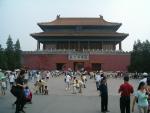
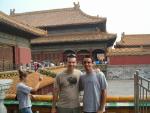
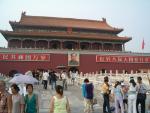
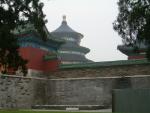
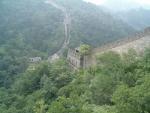
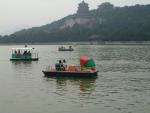
 Copyright © 1998-2025 All rights reserved.
Copyright © 1998-2025 All rights reserved.
1.
Feb 7, 2007 06:41 Reply
TRAVELINGFOOLS said:
Thanks for the detailed write up. It is wonderful to get a tourist eye view.